国外企业安全管理资料
- 格式:doc
- 大小:3.96 MB
- 文档页数:36
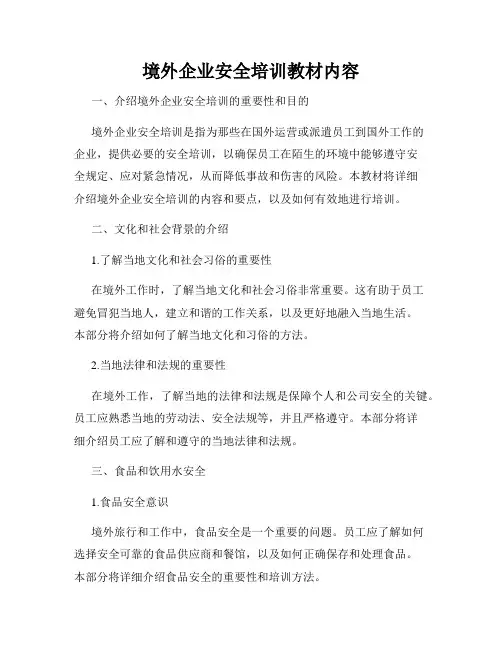
境外企业安全培训教材内容一、介绍境外企业安全培训的重要性和目的境外企业安全培训是指为那些在国外运营或派遣员工到国外工作的企业,提供必要的安全培训,以确保员工在陌生的环境中能够遵守安全规定、应对紧急情况,从而降低事故和伤害的风险。
本教材将详细介绍境外企业安全培训的内容和要点,以及如何有效地进行培训。
二、文化和社会背景的介绍1.了解当地文化和社会习俗的重要性在境外工作时,了解当地文化和社会习俗非常重要。
这有助于员工避免冒犯当地人,建立和谐的工作关系,以及更好地融入当地生活。
本部分将介绍如何了解当地文化和习俗的方法。
2.当地法律和法规的重要性在境外工作,了解当地的法律和法规是保障个人和公司安全的关键。
员工应熟悉当地的劳动法、安全法规等,并且严格遵守。
本部分将详细介绍员工应了解和遵守的当地法律和法规。
三、食品和饮用水安全1.食品安全意识境外旅行和工作中,食品安全是一个重要的问题。
员工应了解如何选择安全可靠的食品供应商和餐馆,以及如何正确保存和处理食品。
本部分将详细介绍食品安全的重要性和培训方法。
2.饮用水安全保证饮用水安全同样重要。
员工应了解如何获取安全清洁的饮用水,并采取适当的处理和消毒措施。
本部分将介绍如何确保供应的饮用水安全合规。
四、交通安全1.了解当地交通规则在境外工作时,了解当地的交通规则对避免交通事故至关重要。
员工应学习和熟悉当地的交通信号、交通标志以及驾驶习惯。
本部分将详细介绍境外交通安全的要点和培训方法。
2.安全驾驶和乘坐交通工具员工应了解安全驾驶和乘坐交通工具的基本原则,包括佩戴安全带、正确使用安全设备等。
本部分将介绍如何安全地驾驶和乘坐各类交通工具。
五、紧急情况和危机管理1.紧急疏散和逃生计划员工应了解如何制定和执行紧急疏散和逃生计划,包括了解紧急出口的位置、距离等信息。
本部分将详细介绍紧急疏散和逃生计划的要点。
2.应对自然灾害和事故在境外,员工可能会面临各种自然灾害和事故,如地震、火灾、恐怖袭击等。
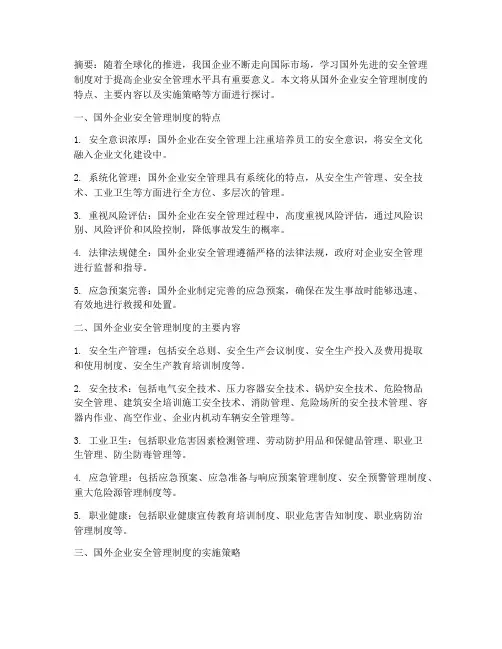
摘要:随着全球化的推进,我国企业不断走向国际市场,学习国外先进的安全管理制度对于提高企业安全管理水平具有重要意义。
本文将从国外企业安全管理制度的特点、主要内容以及实施策略等方面进行探讨。
一、国外企业安全管理制度的特点1. 安全意识浓厚:国外企业在安全管理上注重培养员工的安全意识,将安全文化融入企业文化建设中。
2. 系统化管理:国外企业安全管理具有系统化的特点,从安全生产管理、安全技术、工业卫生等方面进行全方位、多层次的管理。
3. 重视风险评估:国外企业在安全管理过程中,高度重视风险评估,通过风险识别、风险评价和风险控制,降低事故发生的概率。
4. 法律法规健全:国外企业安全管理遵循严格的法律法规,政府对企业安全管理进行监督和指导。
5. 应急预案完善:国外企业制定完善的应急预案,确保在发生事故时能够迅速、有效地进行救援和处置。
二、国外企业安全管理制度的主要内容1. 安全生产管理:包括安全总则、安全生产会议制度、安全生产投入及费用提取和使用制度、安全生产教育培训制度等。
2. 安全技术:包括电气安全技术、压力容器安全技术、锅炉安全技术、危险物品安全管理、建筑安全培训施工安全技术、消防管理、危险场所的安全技术管理、容器内作业、高空作业、企业内机动车辆安全管理等。
3. 工业卫生:包括职业危害因素检测管理、劳动防护用品和保健品管理、职业卫生管理、防尘防毒管理等。
4. 应急管理:包括应急预案、应急准备与响应预案管理制度、安全预警管理制度、重大危险源管理制度等。
5. 职业健康:包括职业健康宣传教育培训制度、职业危害告知制度、职业病防治管理制度等。
三、国外企业安全管理制度的实施策略1. 建立健全安全管理制度:结合企业实际情况,制定完善的安全管理制度,确保安全管理工作的规范化、制度化。
2. 加强安全教育培训:定期开展安全教育培训,提高员工的安全意识和技能。
3. 强化风险识别与控制:通过风险评估,制定风险控制措施,降低事故发生的概率。
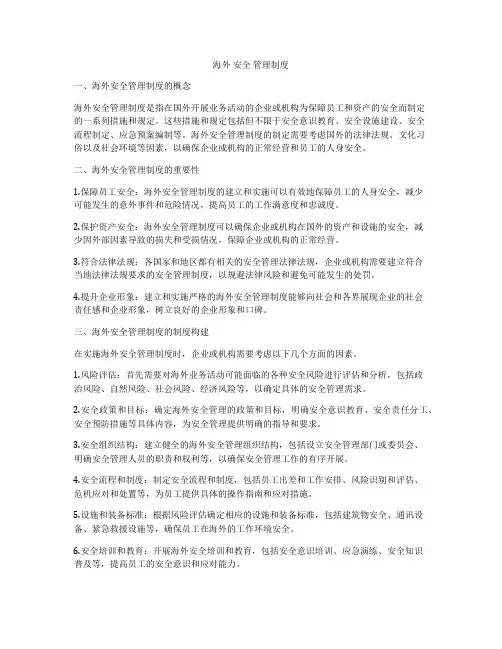
海外安全管理制度一、海外安全管理制度的概念海外安全管理制度是指在国外开展业务活动的企业或机构为保障员工和资产的安全而制定的一系列措施和规定。
这些措施和规定包括但不限于安全意识教育、安全设施建设、安全流程制定、应急预案编制等。
海外安全管理制度的制定需要考虑国外的法律法规、文化习俗以及社会环境等因素,以确保企业或机构的正常经营和员工的人身安全。
二、海外安全管理制度的重要性1.保障员工安全:海外安全管理制度的建立和实施可以有效地保障员工的人身安全,减少可能发生的意外事件和危险情况,提高员工的工作满意度和忠诚度。
2.保护资产安全:海外安全管理制度可以确保企业或机构在国外的资产和设施的安全,减少因外部因素导致的损失和受损情况,保障企业或机构的正常经营。
3.符合法律法规:各国家和地区都有相关的安全管理法律法规,企业或机构需要建立符合当地法律法规要求的安全管理制度,以规避法律风险和避免可能发生的处罚。
4.提升企业形象:建立和实施严格的海外安全管理制度能够向社会和各界展现企业的社会责任感和企业形象,树立良好的企业形象和口碑。
三、海外安全管理制度的制度构建在实施海外安全管理制度时,企业或机构需要考虑以下几个方面的因素。
1.风险评估:首先需要对海外业务活动可能面临的各种安全风险进行评估和分析,包括政治风险、自然风险、社会风险、经济风险等,以确定具体的安全管理需求。
2.安全政策和目标:确定海外安全管理的政策和目标,明确安全意识教育、安全责任分工、安全预防措施等具体内容,为安全管理提供明确的指导和要求。
3.安全组织结构:建立健全的海外安全管理组织结构,包括设立安全管理部门或委员会、明确安全管理人员的职责和权利等,以确保安全管理工作的有序开展。
4.安全流程和制度:制定安全流程和制度,包括员工出差和工作安排、风险识别和评估、危机应对和处置等,为员工提供具体的操作指南和应对措施。
5.设施和装备标准:根据风险评估确定相应的设施和装备标准,包括建筑物安全、通讯设备、紧急救援设施等,确保员工在海外的工作环境安全。
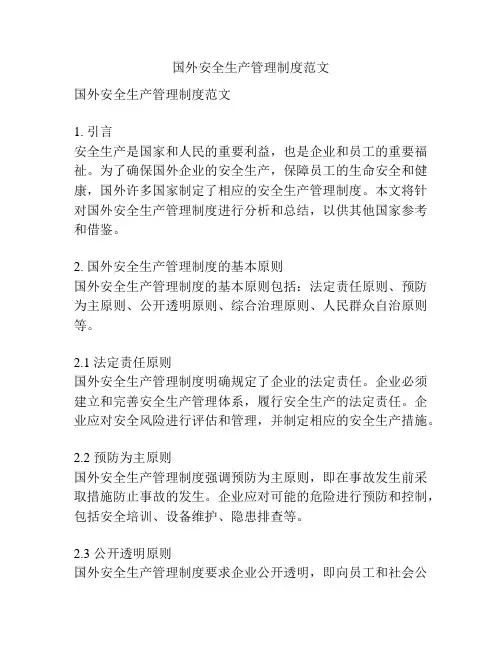
国外安全生产管理制度范文国外安全生产管理制度范文1. 引言安全生产是国家和人民的重要利益,也是企业和员工的重要福祉。
为了确保国外企业的安全生产,保障员工的生命安全和健康,国外许多国家制定了相应的安全生产管理制度。
本文将针对国外安全生产管理制度进行分析和总结,以供其他国家参考和借鉴。
2. 国外安全生产管理制度的基本原则国外安全生产管理制度的基本原则包括:法定责任原则、预防为主原则、公开透明原则、综合治理原则、人民群众自治原则等。
2.1 法定责任原则国外安全生产管理制度明确规定了企业的法定责任。
企业必须建立和完善安全生产管理体系,履行安全生产的法定责任。
企业应对安全风险进行评估和管理,并制定相应的安全生产措施。
2.2 预防为主原则国外安全生产管理制度强调预防为主原则,即在事故发生前采取措施防止事故的发生。
企业应对可能的危险进行预防和控制,包括安全培训、设备维护、隐患排查等。
2.3 公开透明原则国外安全生产管理制度要求企业公开透明,即向员工和社会公众公开安全信息。
企业应及时向员工通报安全生产情况,建立安全生产档案,定期公布事故处理情况。
2.4 综合治理原则国外安全生产管理制度推行综合治理,即通过综合措施治理安全生产问题。
企业应结合技术、管理、监督等手段,推动安全生产管理的综合治理。
2.5 人民群众自治原则国外安全生产管理制度强调人民群众的自治参与。
企业应建立员工参与安全生产的机制,鼓励员工积极参与安全管理和安全教育活动。
3. 国外安全生产管理制度的主要内容国外安全生产管理制度主要包括:法律法规、标准规范、安全管理体系、应急管理等。
3.1 法律法规国外安全生产管理制度根据不同行业和领域的特点,制定了相应的法律法规。
这些法律法规规定了企业的法定责任、安全生产的基本要求、安全生产的管理制度等。
3.2 标准规范国外安全生产管理制度还制定了相应的标准规范。
这些标准规范包括安全生产的管理要求、技术规范、操作规程等。
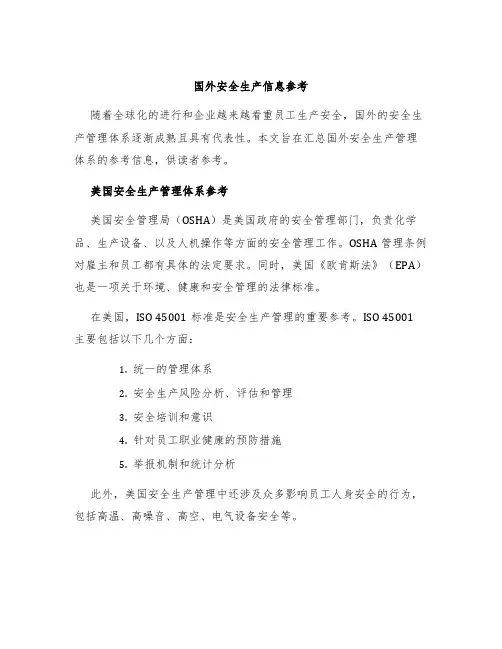
国外安全生产信息参考随着全球化的进行和企业越来越看重员工生产安全,国外的安全生产管理体系逐渐成熟且具有代表性。
本文旨在汇总国外安全生产管理体系的参考信息,供读者参考。
美国安全生产管理体系参考美国安全管理局(OSHA)是美国政府的安全管理部门,负责化学品、生产设备、以及人机操作等方面的安全管理工作。
OSHA管理条例对雇主和员工都有具体的法定要求。
同时,美国《欧肯斯法》(EPA)也是一项关于环境、健康和安全管理的法律标准。
在美国,ISO 45001标准是安全生产管理的重要参考。
ISO 45001主要包括以下几个方面:1.统一的管理体系2.安全生产风险分析、评估和管理3.安全培训和意识4.针对员工职业健康的预防措施5.举报机制和统计分析此外,美国安全生产管理中还涉及众多影响员工人身安全的行为,包括高温、高噪音、高空、电气设备安全等。
欧盟涉及安全生产管理的法律法规和标准也非常严格。
欧盟的安全管理分为各自位于不同国家的安全机构。
欧洲安全局(European Agency for Safety and Health at Work,EU-OSHA)是欧盟委员会设立的机构,致力于在欧洲推广工作场所健康、安全和福利的最佳实践。
欧洲安全管理中,ISO 45001标准同样作为参考依据。
欧洲的劳动安全、职业卫生体系及其相关标准,主要来自德国标准化协会(DIN)、欧洲标准化委员会(CEN)以及欧洲宽度规范体系(EN)。
欧洲极为重视机械操作安全,《欧货车的安全和健康标准》(IOSH)统一制定了一系列的安全标准,包括工程机械和肢体操作设备使用的标准。
日本安全生产管理体系参考日本的安全生产管理同样十分重视人员福利和鼓励员工安全意识。
日本政府及其产业界、学者等构成的研究机构,共同参与企业内外的安全和健康工作。
在日本,对于常见的灾害,如地震、火灾、天气变化等,企业必须制定相应的预防和应对措施。
ISO 45001条例同样是日本安全生产管理的准则之一。
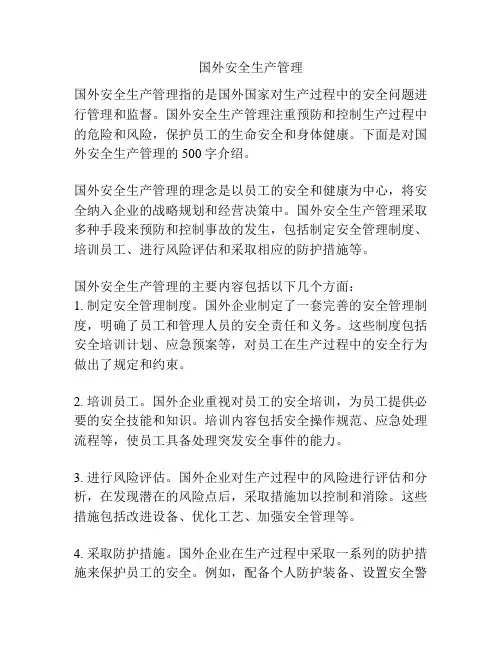
国外安全生产管理国外安全生产管理指的是国外国家对生产过程中的安全问题进行管理和监督。
国外安全生产管理注重预防和控制生产过程中的危险和风险,保护员工的生命安全和身体健康。
下面是对国外安全生产管理的500字介绍。
国外安全生产管理的理念是以员工的安全和健康为中心,将安全纳入企业的战略规划和经营决策中。
国外安全生产管理采取多种手段来预防和控制事故的发生,包括制定安全管理制度、培训员工、进行风险评估和采取相应的防护措施等。
国外安全生产管理的主要内容包括以下几个方面:1. 制定安全管理制度。
国外企业制定了一套完善的安全管理制度,明确了员工和管理人员的安全责任和义务。
这些制度包括安全培训计划、应急预案等,对员工在生产过程中的安全行为做出了规定和约束。
2. 培训员工。
国外企业重视对员工的安全培训,为员工提供必要的安全技能和知识。
培训内容包括安全操作规范、应急处理流程等,使员工具备处理突发安全事件的能力。
3. 进行风险评估。
国外企业对生产过程中的风险进行评估和分析,在发现潜在的风险点后,采取措施加以控制和消除。
这些措施包括改进设备、优化工艺、加强安全管理等。
4. 采取防护措施。
国外企业在生产过程中采取一系列的防护措施来保护员工的安全。
例如,配备个人防护装备、设置安全警示标志、建立安全防护设施等。
5. 建立安全监督体系。
国外企业建立了专门的安全监督机构,定期对企业的安全管理进行检查和评估。
同时,企业也定期进行内部安全审计,及时发现和解决安全问题。
总之,国外安全生产管理注重预防和控制生产过程中的危险和风险,保护员工的生命安全和身体健康。
国外企业通过制定安全管理制度、培训员工、进行风险评估和采取防护措施等手段,提高了生产过程中的安全性,减少了事故的发生。
这些经验和做法对我国的安全生产管理也具有借鉴意义。
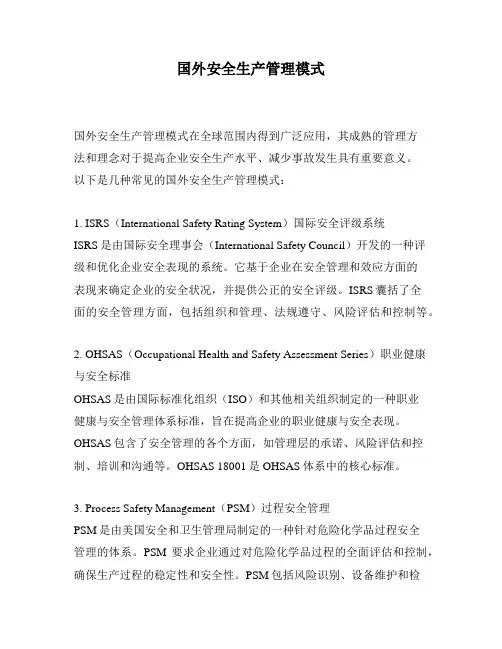
国外安全生产管理模式国外安全生产管理模式在全球范围内得到广泛应用,其成熟的管理方法和理念对于提高企业安全生产水平、减少事故发生具有重要意义。
以下是几种常见的国外安全生产管理模式:1. ISRS(International Safety Rating System)国际安全评级系统ISRS是由国际安全理事会(International Safety Council)开发的一种评级和优化企业安全表现的系统。
它基于企业在安全管理和效应方面的表现来确定企业的安全状况,并提供公正的安全评级。
ISRS囊括了全面的安全管理方面,包括组织和管理、法规遵守、风险评估和控制等。
2. OHSAS(Occupational Health and Safety Assessment Series)职业健康与安全标准OHSAS是由国际标准化组织(ISO)和其他相关组织制定的一种职业健康与安全管理体系标准,旨在提高企业的职业健康与安全表现。
OHSAS包含了安全管理的各个方面,如管理层的承诺、风险评估和控制、培训和沟通等。
OHSAS 18001是OHSAS体系中的核心标准。
3. Process Safety Management(PSM)过程安全管理PSM是由美国安全和卫生管理局制定的一种针对危险化学品过程安全管理的体系。
PSM要求企业通过对危险化学品过程的全面评估和控制,确保生产过程的稳定性和安全性。
PSM包括风险识别、设备维护和检查、作业程序等多个方面。
总的来说,国外安全生产管理模式都强调对企业安全管理的全面性、系统性和有效性的要求,企业需要建立符合本单位实际的管理体系,将标准转化为实际操作。
只有在实践中加强安全意识、不断完善安全管理策略和措施,才能实现最终目标——实现安全生产。
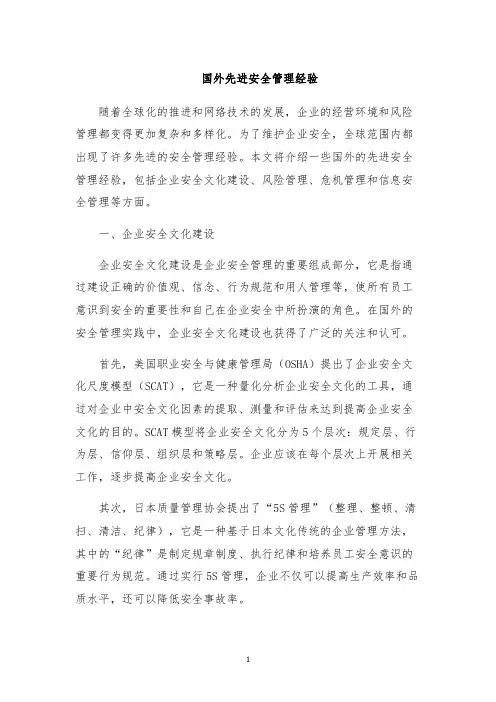
国外先进安全管理经验随着全球化的推进和网络技术的发展,企业的经营环境和风险管理都变得更加复杂和多样化。
为了维护企业安全,全球范围内都出现了许多先进的安全管理经验。
本文将介绍一些国外的先进安全管理经验,包括企业安全文化建设、风险管理、危机管理和信息安全管理等方面。
一、企业安全文化建设企业安全文化建设是企业安全管理的重要组成部分,它是指通过建设正确的价值观、信念、行为规范和用人管理等,使所有员工意识到安全的重要性和自己在企业安全中所扮演的角色。
在国外的安全管理实践中,企业安全文化建设也获得了广泛的关注和认可。
首先,美国职业安全与健康管理局(OSHA)提出了企业安全文化尺度模型(SCAT),它是一种量化分析企业安全文化的工具,通过对企业中安全文化因素的提取、测量和评估来达到提高企业安全文化的目的。
SCAT模型将企业安全文化分为5个层次:规定层、行为层、信仰层、组织层和策略层。
企业应该在每个层次上开展相关工作,逐步提高企业安全文化。
其次,日本质量管理协会提出了“5S管理”(整理、整顿、清扫、清洁、纪律),它是一种基于日本文化传统的企业管理方法,其中的“纪律”是制定规章制度、执行纪律和培养员工安全意识的重要行为规范。
通过实行5S管理,企业不仅可以提高生产效率和品质水平,还可以降低安全事故率。
最后,德国安全顾问公司先锋卡宾(TÜV Rheinland)提出了“合规性文化”(Compliance Culture)的概念,它是通过主动遵守法规、规范和企业伦理,形成一种合规性意识,从而实现企业的持续发展和安全保障。
在合规性文化中,企业应该培养员工的风险意识和安全意识,营造一个“安全先、合规先”的工作氛围。
二、风险管理风险管理是指通过对潜在风险进行识别、分析、评估和控制等一系列工作,有效地减少和控制企业在经营过程中所面临的各种风险。
在国外安全管理实践中,风险管理被认为是保障企业安全的重要手段。
首先,美国挑战过程(Challenge Process)是一种常用的风险评估方法,它通过验证系统设计中的风险控制措施、审核系统性缺陷和测试系统性能等方式,识别可能存在的风险,并通过改进或加强措施来消除或减少风险。
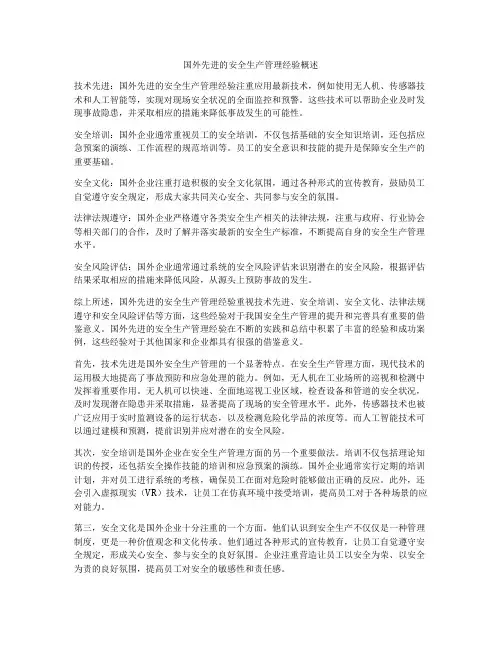
国外先进的安全生产管理经验概述技术先进:国外先进的安全生产管理经验注重应用最新技术,例如使用无人机、传感器技术和人工智能等,实现对现场安全状况的全面监控和预警。
这些技术可以帮助企业及时发现事故隐患,并采取相应的措施来降低事故发生的可能性。
安全培训:国外企业通常重视员工的安全培训,不仅包括基础的安全知识培训,还包括应急预案的演练、工作流程的规范培训等。
员工的安全意识和技能的提升是保障安全生产的重要基础。
安全文化:国外企业注重打造积极的安全文化氛围,通过各种形式的宣传教育,鼓励员工自觉遵守安全规定,形成大家共同关心安全、共同参与安全的氛围。
法律法规遵守:国外企业严格遵守各类安全生产相关的法律法规,注重与政府、行业协会等相关部门的合作,及时了解并落实最新的安全生产标准,不断提高自身的安全生产管理水平。
安全风险评估:国外企业通常通过系统的安全风险评估来识别潜在的安全风险,根据评估结果采取相应的措施来降低风险,从源头上预防事故的发生。
综上所述,国外先进的安全生产管理经验重视技术先进、安全培训、安全文化、法律法规遵守和安全风险评估等方面,这些经验对于我国安全生产管理的提升和完善具有重要的借鉴意义。
国外先进的安全生产管理经验在不断的实践和总结中积累了丰富的经验和成功案例,这些经验对于其他国家和企业都具有很强的借鉴意义。
首先,技术先进是国外安全生产管理的一个显著特点。
在安全生产管理方面,现代技术的运用极大地提高了事故预防和应急处理的能力。
例如,无人机在工业场所的巡视和检测中发挥着重要作用。
无人机可以快速、全面地巡视工业区域,检查设备和管道的安全状况,及时发现潜在隐患并采取措施,显著提高了现场的安全管理水平。
此外,传感器技术也被广泛应用于实时监测设备的运行状态,以及检测危险化学品的浓度等。
而人工智能技术可以通过建模和预测,提前识别并应对潜在的安全风险。
其次,安全培训是国外企业在安全生产管理方面的另一个重要做法。
培训不仅包括理论知识的传授,还包括安全操作技能的培训和应急预案的演练。

国外企业安全管理资料国外企业安全管理1. BP职能化的安全管理机构• 职能部门向总经理汇报,但同时向直属上级报告,业绩主要由职能上级考核 • 职能部门具有相对独立性• 不同成员公司安全人员形成一个网络,会承担一定上级的任务总经理销售 经理安全 顾问人力 资源 顾问工厂 厂长运作 经理财务 经理供应 采购 经理信息 技术 顾问2.道达尔佛山工厂组织架构: 134 人3.杜邦4. 广本交通、防火、生产安全委员会机构图广州本田汽车有限公司5.ABB6.ACCO(每个职位的职责看原文)7.阿美科(AMEC)8.巴斯夫9.贝克休斯Enterprise employee injury/illness performance We achieved a 14% reduction in 2013 Total Recordable Incident Rate (TRIR), surpassing our 10% goal for the year. Although 66 fewer recordable incidents occurred than in the previous year, 580 employees still suffered a recordable injury. In addition to successfully lowering our TRIR, we achieved an 18% reduction in our Days Away From Work Case Rate (DAFWCR). Our key HSE performance metrics continue to outperform the International Association of Drilling Contractors benchmark, and are in the top quartile across the industry (Fig. 2).Our loss control triangle (Fig. 3) shows that employees submitted 487,060 observations in 2013, a 20% increase year-on-year. This increase correlates directly with our improved safety and environmental performance.Injury/illness data analysisFigs. 4 and 5 illustrate the top five injured body parts and the six most common types of injuries sustained in 2013. Hand and back injuries continue to be the most frequent body parts affected. Combined, these injuries constitute 44% of the recordable injuries for the year (Fig.4). Although sprains and strains continueto be the most prevalent type of injury, we experienced a 14% reduction compared to 2012 and 31% compared to 2011 (Fig. 5). Recordable injuries predominantly occurred at the wellsite or at a Baker Hughes facility. Together these locations accounted for 82% of the recordable injuries (Fig. 6).Transportation safetyOur transportation safety performance improved last year. Our recordable Motor Vehicle Accident frequency improved 4%, and our overall accident frequency rate (all severity classifications) decreased by more than 9%. While these are very encouraging results, we still have many opportunities for improvement. As in the past, the majority of our recordable accidents were due to a combination of factors, but excessive speed for road and weather conditions, improper following distance, poor driver awareness of surroundings and inconsistent journey management practices continue to be our most frequent contributors,reflecting the need for continued training and strong oversight programs.To address these issues, we completed a thorough driving training program strategy addressing not only the Baker Hughesspecific driver training components (core defensive driving), but also driver trainers and assessors (Transportation Trainer and Assessor Certification Course). Further support for these two programs will come with the introduction of the Transportation Safety Management Leadership Program in Q1 2014. All three programs will also be introduced globally. And, we have initiated plans to pilot a state-of-theart driving simulator.10.福陆11.哈利伯顿During 2013, we achieved a strong safety performance with a 26 percent decline in injury rates. This is one of the greatest yearover-year improvements we have ever seen, and it speaks to the dedication, all across our organization, to ensure that everyone returns home safe.Key Achievements•As we continue to work toward our ultimate goal of ZERO, we reduced our total recordable incident rate (TRIR) to 0.59 in 2013. This represents our best performance, and a 70 percent decline, since the Company began keeping consolidated records in 1999. Our 2013 lost-time incident rate (LTIR) of 0.14 represents our best performance, and an 86 percent decline, compared to 1999.•We reduced both the volume of spills and our carbon footprint in 2013. Additionally, we enhanced our comprehensive chemical index and continue to advance our emissions reducing dual-fuel technology.•We completed a full update of our corporate health, safety and environmental standards. These standards define the minimum expectations for the control of an HSE activity or system, and serve as a bridge between regulatory r equirements and Halliburton’s operations.12.霍尼韦尔HSE Structure and Responsibility1. APPLICABILITY1.1 This standard applies to all Honeywell organizations and majority owned subsidiaries worldwide.2. OVERVIEW2.1 An o rganization’s HSE Management System will only be as successful as the level of commitment demonstrated by its leadershipand employees. One important method used to gain and maintain high levels of commitment is the establishment of specific HSE roles and r esponsibilities throughout the organization’sstructure. Operational controls are designed to manage HSE aspects, risks and obligations but controls are only as good as the individual efforts to implement and maintain those controls. Establishing clear roles and responsibility for the management system and resulting controls will help the organization implementits management system, sustain control over its HSE aspects and drive commitment throughout the workforce. This standard will help organizations implement and maintainan effective HSE management system by establishing clear lines of responsibility and accountability.3. DEFINITIONS3.1 Definitions for underlined text are found at the end of this document.4. REQUIREMENTS4.1 The organization shall identify and documentHSE roles and responsibilities necessary to establish and maintain an effective HSE management system. Roles andresponsibilities must be established for all employees including the following organization levels:4.1.1 Those who manage activities that have or could have an impact on the organization’s HSE performance, including Senior Leadership, managers, supervisors and functional HSE leaders4.1.2 Personnel who perform tasks and activities that have HSE risks or are included in th e organization’s identified significant aspects, including employees and contractors4.1.3 Personnel who verify HSE performance for the organization including those performing audits, self-assessments, inspections and monitoring activities4.2 The orga nization’s senior leader is ultimately responsible and accountable for HSE performance and the performance of the HSE Management System. The organization’s senior leadership shall appoint a specific management representative who, irrespective of otherresponsibilities, shall have defined roles, responsibilities and authority for ensuring that the HSE management system requirements are established, implemented and maintained. This requirement shall be achieved by appointing one of the following individuals:4.2.1 The organization’s senior leader (self-appointed)4.2.2 A direct report to the organization’s senior leader4.2.3 A management representative with direct and regular access to the senior leader for the purposes of communicating and driving the HSE management system4.3 Roles and responsibilities must be assigned for all activities of the HSE Management System (e.g. operational controls, managementprograms, HSE procedures, objectives, training, etc.).4.4 Operational Controls must include assignment of responsibility for control (procedure, etc) requirements. Where possible, responsibilities shall be assigned to theindividual(s) that have authority and responsibility for the operation, activity or risk to be controlled.4.5 Those assigned specific HSE responsibilities must be at a level in the organization where they have adequate authority, resources and operational knowledge to successfully carry out their responsibilities. 4.6 HSE performance expectations must be included and documented in the performance management process for all individuals assigned specific HSE responsibilities.5. RELATED DOCUMENTS5.1 None defined now.13.卡特彼勒From 2012 to 2013, we continued to build upon a trend toward world-class standards in safety with a 24 percent reduction in Recordable Injury Frequency (RIF) and a 3 percent reduction inLost-Time Case Frequency Rate (LTCFR).坐落在无锡市的卡特彼勒(中国)机械部件有限公司时刻将安全放在第一位,并致力于创建一种集教育、提示和汇报于一体的安全文化。
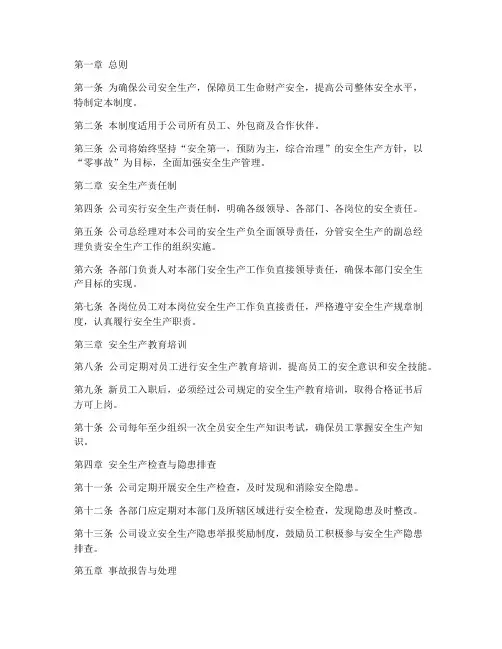
第一章总则第一条为确保公司安全生产,保障员工生命财产安全,提高公司整体安全水平,特制定本制度。
第二条本制度适用于公司所有员工、外包商及合作伙伴。
第三条公司将始终坚持“安全第一,预防为主,综合治理”的安全生产方针,以“零事故”为目标,全面加强安全生产管理。
第二章安全生产责任制第四条公司实行安全生产责任制,明确各级领导、各部门、各岗位的安全责任。
第五条公司总经理对本公司的安全生产负全面领导责任,分管安全生产的副总经理负责安全生产工作的组织实施。
第六条各部门负责人对本部门安全生产工作负直接领导责任,确保本部门安全生产目标的实现。
第七条各岗位员工对本岗位安全生产工作负直接责任,严格遵守安全生产规章制度,认真履行安全生产职责。
第三章安全生产教育培训第八条公司定期对员工进行安全生产教育培训,提高员工的安全意识和安全技能。
第九条新员工入职后,必须经过公司规定的安全生产教育培训,取得合格证书后方可上岗。
第十条公司每年至少组织一次全员安全生产知识考试,确保员工掌握安全生产知识。
第四章安全生产检查与隐患排查第十一条公司定期开展安全生产检查,及时发现和消除安全隐患。
第十二条各部门应定期对本部门及所辖区域进行安全检查,发现隐患及时整改。
第十三条公司设立安全生产隐患举报奖励制度,鼓励员工积极参与安全生产隐患排查。
第五章事故报告与处理第十四条事故发生后,事故单位应立即启动应急预案,采取措施控制事故扩大。
第十五条事故单位应在事故发生后24小时内向公司安全生产管理部门报告事故情况。
第十六条公司安全生产管理部门负责事故调查、处理和责任追究。
第十七条事故调查组应全面调查事故原因,提出处理意见,报公司领导批准后实施。
第六章应急预案第十八条公司建立健全应急预案体系,包括综合应急预案、专项应急预案和现场处置方案。
第十九条公司定期组织应急演练,提高员工应对突发事件的能力。
第七章附则第二十条本制度由公司安全生产管理部门负责解释。
第二十一条本制度自发布之日起实施。
境外企业安全生产1、如何将国内外先进的安全生产时效经验,应用于煤炭企业?将国内外先进的安全生产时效经验,应用于煤炭企业健全完善的安全法制。
独立严格的监察机制。
严格的上岗培训教育。
先进适用的技术支撑。
2、企业安全生产第一责任人是总经理还是董事长企业安全生产第一责任人是董事长,因为董事长是企业的主要负责人。
生产经营单位的主要负责人和安全生产管zd理人员必须具备与本单位所从事的生产经营活动相应的安全生产知识和管理能力。
危险物品的生产、经营、储存单位以及矿山、建筑施工单位的主要负责人和安全生产管理人员,应当由有关主管部门对其安全生产知识和管理能力考核合格后方可任职。
考核不得收费。
生产经营单位应当对从业人员进行安全生产教育和培训,保证从业人员具备必要的安全生产知识,熟悉有关的安全生产规章制度和安全操作规程,掌握本岗位的安全操作技能。
未经安全生产教育和培训合格的从业人员,不得上岗作业。
(2)境外企业安全生产扩展资料生产经营单位的主要负责人对本单回位安全生产工作负有下列职责:(一)建立、健全本单位安全生产责任制。
(二)组织制定本单位安全生产规章答制度和操作规程。
(三)保证本单位安全生产投入的有效实施。
(四)督促、检查本单位的安全生产工作,及时消除生产安全事故隐患。
(五)组织制定并实施本单位的生产安全事故应急救援预案。
(六)及时、如实报告生产安全事故。
3、国外对重大安全生产风险是怎样控制的国外重大安全生产风险的控制可以参考下面的这篇文章,也可以说是作业环境场所、能源管控及规范人员行为的安全管理控制,鄙人另加一条作业人员安全的协调与管理。
安全生产管理涉及企业单位的方方面面,不是三言两语可以概括的,仅供参考!英国:制定和颁布安全法规英国是西方最早实现工业化的国家。
在长期的工业活动中,人们逐步认识到涉及危险物质的工业活动极有可能导致事故的发生。
一些事故不仅对工人,而且对周边环境、甚至对远离事故现场的地方都会构成不同程度的危害。
在全球化的大背景下,国外企业以其先进的管理理念和技术实力在全球范围内发挥着重要作用。
为了保障员工的生命安全和身体健康,国外企业普遍建立了完善的安全生产管理制度,以下将从几个方面介绍国外企业的安全生产管理制度。
一、安全文化培育国外企业高度重视安全文化建设,将安全生产理念融入企业核心价值观。
通过举办安全知识竞赛、安全培训等活动,提高员工的安全意识,使安全成为企业员工的自觉行为。
二、安全责任制国外企业实行安全责任制,明确各级领导和员工的安全职责。
企业高层领导负责制定安全政策、规划,中层管理人员负责组织落实,基层员工负责具体执行。
安全责任制确保了安全生产的层层落实。
三、安全培训与教育国外企业注重员工的安全培训与教育,定期开展安全培训课程,使员工掌握必要的安全生产知识和技能。
同时,企业还会邀请专业机构进行安全评估,确保培训内容的针对性和实用性。
四、安全检查与隐患治理国外企业定期进行安全检查,及时发现并消除安全隐患。
安全检查覆盖生产、办公、仓储等各个领域,确保安全措施落实到位。
对于发现的问题,企业会制定整改措施,确保隐患得到有效治理。
五、应急预案与应急演练国外企业制定详细的应急预案,针对可能发生的各类事故进行应对。
企业定期组织应急演练,提高员工应对突发事件的能力。
应急演练包括火灾、地震、泄漏等场景,确保员工在紧急情况下能够迅速、有序地应对。
六、安全投入与设备管理国外企业重视安全投入,配备先进的安全生产设备,降低事故发生的概率。
同时,企业对设备进行定期检查、维护,确保设备安全可靠。
七、职业健康与环境保护国外企业关注员工的职业健康,定期进行职业健康检查,为员工提供健康保障。
此外,企业还关注环境保护,采用清洁生产技术,减少对环境的影响。
八、持续改进与评估国外企业注重安全生产的持续改进与评估。
通过定期对安全生产管理制度进行评估,发现问题并及时整改,不断提高安全生产水平。
总之,国外企业的安全生产管理制度在以下几个方面表现出显著特点:1. 安全文化培育;2. 安全责任制;3. 安全培训与教育;4. 安全检查与隐患治理;5. 应急预案与应急演练;6. 安全投入与设备管理;7. 职业健康与环境保护;8. 持续改进与评估。
国外先进的EHS管理知识一、背景与概述环境、健康和安全(EHS)管理是组织内部管理的一部分,旨在确保组织在实践中能够对员工健康和环境保护采取积极和及时的措施。
在国外,EHS管理一直是企业可持续发展和全球竞争力的重要组成部分。
本文将探讨国外一些先进的EHS管理知识。
二、EHS标准和指南1. OHSAS 18001OHSAS 18001是一种国际标准,涵盖了健康与安全管理体系的要求,它为企业提供了建立和实施有效健康与安全管理体系的框架。
该标准要求企业识别和评估健康与安全风险,并采取适当的控制措施以确保员工的安全和健康。
2. ISO 14001ISO 14001是一种国际标准,涵盖了环境管理体系的要求,旨在协助企业管理环境方面的风险和机会。
该标准要求企业考虑环境因素,并制定相应的政策、目标和计划以减少对环境的负面影响。
三、EHS风险评估和管理有效的EHS风险评估和管理是确保企业员工健康与安全的关键。
国外一些先进企业采用系统化的方法来识别和评估风险,并通过实施有效的控制措施来管理这些风险。
四、EHS培训和意识提升培训和意识提升是确保员工遵守EHS政策和程序的重要环节。
国外先进企业会定期组织EHS培训,提高员工对EHS重要性的认识,使其能够采取适当的行动来保护自己和同事的健康与安全。
五、EHS绩效评估与改进衡量EHS绩效并进行持续改进是确保企业持续遵守EHS法规和标准的关键。
国外一些领先企业会定期评估其EHS绩效,并采取必要的措施来改进绩效,不断提升EHS管理水平。
结语国外先进的EHS管理知识为企业提供了一种有效的方法来管理员工健康与安全,并降低对环境的影响。
通过遵循相关标准和指南、实施系统化的风险评估和管理、注重培训和意识提升,以及持续评估绩效与改进,企业能够提高EHS管理水平,实现可持续发展目标。
国外先进安全管理经验随着现代社会的快速发展,全球范围内的安全问题日益严峻。
为了确保个人的生命健康和财产安全,各国政府和企业都开始重视安全管理的作用,不断探索和借鉴国外先进的安全管理经验。
本文将从几个方面探讨国外先进的安全管理经验,以及它们在实践中的应用。
安全文化建设安全文化建设是提高员工安全意识和行为的一个重要途径。
国外先进企业通过采用多种方式,如开展安全培训、组织安全演习和建立安全管理制度等,推广安全文化,并深入员工生产、生活等各个方面,提高员工安全意识和责任感。
以诺基亚公司为例,该公司建立了一套严格的安全体系,使员工的安全意识和行为成为公司的一部分。
除了安全培训和安全管理制度的执行之外,诺基亚公司还组织安全演习来检验员工的应对能力,并引导员工在工作和生活中注意维护自身和他人的安全。
通过这些措施,诺基亚公司建立了良好的安全文化,并在业界赢得了良好的声誉。
人性化安全管理人性化安全管理是指对员工的身心保护和关怀,以促进员工的身心健康和稳定工作。
这种管理方法可以有效地提高员工的安全意识和责任感,打造一个安全、和谐的工作环境。
谷歌公司是一个成功的人性化安全管理的典范。
从员工进入公司到成为一名谷歌员工,该公司为每一位员工提供了多种健康和安全的保障,如职业健康管理、智能健身房和健身课程等,并提供24小时保安和医疗服务。
通过这些细致入微的安全保障和关怀,谷歌公司吸引了许多优秀的员工,使员工更加重视安全和身体健康。
科技创新应用科技创新是提高安全管理水平的重要手段之一,许多国外企业通过引进新技术和创新应用来提高安全管理水平,更好地保护员工和企业的财产安全。
特斯拉公司的安全管理就采用了许多科技创新。
该公司将最先进的安全技术应用到了汽车设计中,如自动驾驶系统、碰撞预警系统、行车记录仪等,从而大大提高了车辆和驾驶员的安全性。
此外,特斯拉公司通过区块链技术和物联网技术,实现对纪录数据的可信性、可追溯性,为车主提供了更加安全和可靠的车辆使用体验。
国外安全生产管理在国外,安全生产管理是指针对生产过程中的安全问题进行管理和控制的一种措施。
国外对安全生产管理非常重视,从法律法规、制度规定到行业标准都给予了严格的要求和监督。
首先,国外对安全生产管理进行了立法,制定了相应的法律法规来规范和保障安全生产。
比如,美国的《安全与健康法案》和欧盟的《安全与卫生框架指令》等,这些法律法规明确了企业在安全生产方面的责任和义务,同时也规定了罚则和处罚措施,以确保法律的有效实施。
其次,国外还建立了相应的安全生产管理制度。
企业必须制定和落实一系列安全管理制度,包括安全生产政策、安全生产责任制、安全生产规章制度等。
这些制度要求企业建立科学的安全生产管理机制和体系,明确安全生产的目标、原则和标准,以及各级管理人员的职责与依据,并对违规的行为和事故进行惩处和追责。
此外,国外还注重安全培训和安全技术的推广应用。
企业必须进行相关安全培训,提高员工的安全意识和技能,确保每个员工都具备相关的安全知识和技术。
同时,国外也鼓励企业采用最新的安全技术,如安全监控系统、防护设备、警报器等,以降低事故的发生率和减小事故的危害。
最后,在国外,安全生产管理还需要进行有效的监控和评估。
企业必须建立健全的安全监控机制,对生产过程中的各项指标进行监测和评估,及时发现和解决安全隐患。
同时,还要进行定期的安全检查和评估,对企业的安全生产管理水平进行评价,及时纠正不足和薄弱环节。
总之,国外安全生产管理是一个综合性的体系,需要依靠法律法规、制度规定和科学技术等多方面的支持。
通过建立完善的安全管理机制和体系,加强安全培训和技术推广应用,有效监控和评估安全状况,将能够有效预防和减少事故的发生,保障员工的人身安全和生产设备的正常运行。
国外企业安全管理1. BP职能化的安全管理机构• 职能部门向总经理汇报,但同时向直属上级报告,业绩主要由职能上级考核 • 职能部门具有相对独立性• 不同成员公司安全人员形成一个网络,会承担一定上级的任务总经理销售 经理安全 顾问人力 资源 顾问工厂 厂长运作 经理财务 经理供应 采购 经理信息 技术 顾问2.道达尔佛山工厂组织架构: 134 人3.杜邦4.广本广州本田汽车有限公司交通、防火、生产安全委员会机构图5.ABB6.ACCO(每个职位的职责看原文)7.阿美科(AMEC)8.巴斯夫9.贝克休斯Enterprise employee injury/illness performanceWe achieved a 14% reduction in 2013 Total Recordable Incident Rate (TRIR), surpassing our 10% goal for the year. Although 66 fewer recordable incidents occurred than in the previous year, 580 employees still suffered a recordable injury. In addition to successfully lowering our TRIR, we achieved an 18% reduction in our Days Away From Work Case Rate (DAFWCR). Our key HSE performance metrics continue to outperform the International Association of Drilling Contractors benchmark, and are in the top quartile across the industry (Fig. 2).Our loss control triangle (Fig. 3) shows that employees submitted 487,060 observations in 2013, a 20% increase year-on-year. This increase correlates directly with our improved safety and environmental performance.Injury/illness data analysisFigs. 4 and 5 illustrate the top five injured body parts and the six most common types of injuries sustained in 2013. Hand and back injuries continue to be the most frequent body parts affected. Combined, these injuries constitute 44% of the recordable injuries for the year (Fig. 4). Although sprains and strains continueto be the most prevalent type of injury, we experienced a 14% reduction compared to 2012 and 31% compared to 2011 (Fig. 5). Recordable injuries predominantly occurred at the wellsite or at a Baker Hughes facility. Together these locations accounted for 82% of the recordable injuries (Fig. 6).Transportation safetyOur transportation safety performance improved last year. Our recordable Motor Vehicle Accident frequency improved 4%, and our overall accident frequency rate (all severity classifications) decreased by more than 9%. While these are very encouraging results, we still have many opportunities for improvement. As in the past, the majority of our recordable accidents were due to a combination of factors, but excessive speed for road and weather conditions, improper following distance, poor driver awareness of surroundings and inconsistent journey management practices continue to be our most frequent contributors, reflecting the need for continued training and strong oversight programs.To address these issues, we completed a thorough driving training program strategy addressing not only the Baker Hughesspecific driver training components (core defensive driving), but also driver trainers and assessors (Transportation Trainer and Assessor Certification Course). Further support for these two programs will come with the introduction of the Transportation Safety Management Leadership Program in Q1 2014. All three programs will also be introduced globally. And, wehave initiated plans to pilot a state-of-theart driving simulator.10.福陆11.哈利伯顿During 2013, we achieved a strong safety performance with a 26 percent decline in injury rates. This is one of the greatest yearover-year improvements we have ever seen, and it speaks to the dedication, all across our organization, to ensure that everyone returns home safe.Key Achievements•As we continue to work toward our ultimate goal of ZERO, we reduced our total recordable incident rate (TRIR) to 0.59 in 2013. This represents our best performance, and a 70 percent decline, since the Company began keeping consolidated records in 1999. Our 2013 lost-time incident rate (LTIR) of 0.14 represents our best performance, and an 86 percent decline, compared to 1999.•We reduced both the volume of spills and our carbon footprint in 2013. Additionally, we enhanced our comprehensive chemical index and continue to advance our emissions reducing dual-fuel technology.•We completed a full update of our corporate health, safety and environmental standards. These standards define the minimum expectations for the control of an HSE activity or system, and serve as a bridge between regulatory requirements a nd Halliburton’s operations.12.霍尼韦尔HSE Structure and Responsibility1. APPLICABILITY1.1 This standard applies to all Honeywell organizations and majority owned subsidiaries worldwide.2. OVERVIEW2.1 An organization’s HSE Management System will only be as successful as the level of commitment demonstrated by its leadershipand employees. One important method used to gain and maintain high levels of commitment is the establishment of specific HSE roles and responsibiliti es throughout the organization’s structure. Operational controls are designed to manage HSE aspects, risks and obligations but controls are only as good as the individual efforts to implement and maintain those controls. Establishing clear roles and responsibility for the management system and resulting controls will help the organization implementits management system, sustain control over its HSE aspects and drive commitment throughout the workforce. This standard will help organizations implement and maintainan effective HSE management system by establishing clear lines of responsibility and accountability.3. DEFINITIONS3.1 Definitions for underlined text are found at the end of this document.4. REQUIREMENTS4.1 The organization shall identify and documentHSE roles and responsibilities necessary to establish and maintain an effective HSE management system. Roles and responsibilities must be established for all employees including the following organization levels:4.1.1 Those who manage activities that have or could have an impact on the organization’s HSE performance, including Senior Leadership, managers, supervisors and functional HSE leaders4.1.2 Personnel who perform tasks and activities that have HSE risks or are included in the organizatio n’s identified significant aspects, including employees and contractors4.1.3 Personnel who verify HSE performance for the organization including those performing audits, self-assessments, inspections and monitoring activities4.2 The organization’s se nior leader is ultimately responsible and accountable for HSE performance and the performance of the HSE Management System. The organization’s senior leadership shall appoint a specific management representative who, irrespective of other responsibilities, shall have defined roles, responsibilities and authority for ensuring that the HSE management system requirements are established, implemented and maintained. This requirement shall be achieved by appointing one of the following individuals:4.2.1 The o rganization’s senior leader (self-appointed)4.2.2 A direct report to the organization’s senior leader4.2.3 A management representative with direct and regular access to the senior leader for the purposes of communicating and driving the HSE management system4.3 Roles and responsibilities must be assigned for all activities of the HSE Management System(e.g. operational controls, managementprograms, HSE procedures, objectives, training, etc.).4.4 Operational Controls must include assignment of responsibility for control (procedure, etc) requirements. Where possible, responsibilities shall be assigned to the individual(s) that have authority and responsibility for the operation, activity or risk to be controlled.4.5 Those assigned specific HSE responsibilities must be at a level in the organization wherethey have adequate authority, resources and operational knowledge to successfully carry out their responsibilities.4.6 HSE performance expectations must be included and documented in the performance management process for all individuals assigned specific HSE responsibilities.5. RELATED DOCUMENTS5.1 None defined now.13.卡特彼勒From 2012 to 2013, we continued to build upon a trend toward world-class standards in safety with a 24 percent reduction in Recordable Injury Frequency (RIF) and a 3 percent reduction in Lost-Time Case Frequency Rate (LTCFR).坐落在无锡市的卡特彼勒(中国)机械部件有限公司时刻将安全放在第一位,并致力于创建一种集教育、提示和汇报于一体的安全文化。